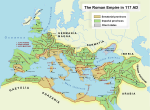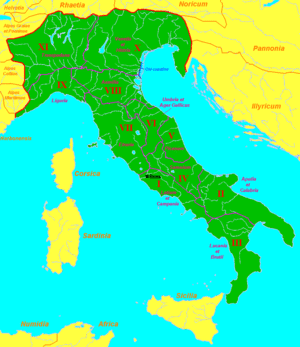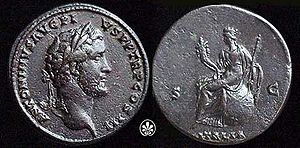- Italy (Roman Empire)
-
 A portion of the Tabula Peutingeriana, a Roman map of the 4th century, depicting the southern part of Italia.
A portion of the Tabula Peutingeriana, a Roman map of the 4th century, depicting the southern part of Italia.
Italia was the name of the Italian peninsula of the Roman Empire.
Contents
Under the Republic and Augustan organization
During the Republic and the first centuries of the empire, Italia (which extended at the beginning from Calabria to Rubicon later from Calabria to Alps) was not a province, but rather the territory of the city of Rome, thus having a special status: for example, military commanders were not allowed to bring their armies within Italia, and Julius Caesar passing the Rubicon with his legions marked the start of the civil war.
The name Italia covered an area of land whose borders evolved over time. According to Strabo (Geographia, v 1), at the beginning the name indicated the land between the strait of Messina and the line connecting the gulf of Salerno and gulf of Taranto; later Italia was extended to include the whole Italian peninsula, as well as the Istrian town of Colonia Pietas Iulia (Pola); finally, Julius Caesar gave Roman citizenship to the people of the Gallia Transpadana— that part of Cisalpine Gaul that lay "beyond the Po"—, thus extending Italia up to the Alps.
With the end of the Social War (91–88 BC), Rome allowed the Italian allies to enter with full rights in the Roman society, giving the Roman citizenship to all the Italic peoples.
At the beginning of the Empire, Italia was a collection of territories with different statuses. Some cities, called municipii, had some independence from Rome, others, the colonies, were founded by the Romans themselves. Around 7 BC, Augustus Caesar divided Italia into eleven regiones, as reported by Pliny the Elder in his Naturalis Historia (iii 46):
- Regio I Latium et Campania
- Regio II Apulia et Calabria
- Regio III Lucania et Brutii
- Regio IV Samnium
- Regio V Picenum
- Regio VI Umbria et Ager Gallicus
- Regio VII Etruria
- Regio VIII Aemilia
- Regio IX Liguria
- Regio X Venetia et Histria
- Regio XI Transpadana
Italia was privileged by Augustus and his heirs, with the construction, among other public structures, of a dense mesh of roads. The Italian economy flourished: agriculture, handicraft and industry had a sensible growth, allowing the export of goods to the other provinces. The Italian population grew as well: Three census were ordered by Augustus, to record the presence of male citizens in Italia. They were 4,063,000 in 28 BC, 4,233,000 in 8 BC, and 4,937,000 in AD 14. Including the women and the children, the total population of Italia at the beginning of the 1st century was around 10 million.
Italia in 3rd century
When Roman citizenship was given to all the Empire (in the year 212), Italia began to decline in favour of the provinces. Furthermore, Italian territory suffered from the attacks of barbarian tribes, which happened at the end of the 3rd century (see Crisis of the third century and Barracks emperors).
Diocletian divided the Empire into four parts (dioceses). The diocesis Italiae, ruled by the Augustus of the West, was divided into two zones, each divided into smaller territories held by correctores:
- Italia suburbicaria ("under the government of Rome")
- Tuscia et Umbria
- Valeria
- Campania et Samnium
- Apulia et Calabria
- Sicilia
- Sardinia et Corsica
- Italia annonaria, with capital Mediolanum (Milan)
- Venetia et Histria
- Aemilia et Liguria
- Flaminia et Picenum
- Raetia
- Alpes Cottiae
The former Italian regions of Alpes Poenninae and Alpes Maritimae become part of the Diocesis Galliarum.
Italia from the 4th to the 6th century
When the barbarians became the most important problem, the Emperors were obliged to move out of Rome, and even in other provinces, thus increasing even more the decline of Italia. In 330, Constantine I moved the capital of the empire to Constantinople, with the imperial court, economical administration, as well as the military structures (as the fleets of Misenum and Ravenna).
After the death of emperor Theodosius (395), Italia became part of the Western Roman Empire. Then came the years of the barbarian invasions, and the capital was moved from Mediolanum to Ravenna (402). Alaric, king of Visigoths, sacked Rome itself in 410; something that hadn't happened for eight centuries. Northern Italia was attacked by Attila's Huns, and Rome was sacked again by the Vandals under the command of Genseric in 455.
According to Notitia Dignitatum, a compilation of public civil and military officers that is considered updated to 420s for the western part of the Roman Empire, Italia was governed by a prefectus, Prefectus praetorio Italiae (who governed Gaul, Italia, Illyricum and Africa), one vicarius, and one comes rei militaris. The regions were governed by eight consulares (Venetiae et Histriae, Aemiliae, Liguriae, Flaminiae et Piceni annonarii, Tusciae et Umbriae, Piceni suburbicarii, Campaniae, and Siciliae), two correctores (Apuliae et Calabriae and Lucaniae et Bruttiorum) and four praesides (Alpium Cottiarum, Samnii, Sardiniae, and Corsicae).
With the Emperors controlled by their barbarian generals, the imperial government weakly controlled Italia, whose coasts were continuously under attack. In 476, with the resignation of Romulus Augustulus and the return of the imperial ensigns to Constantinople, the Western Roman Empire had fallen. For 77 years, Italia stayed united first under Odoacer, then under the Ostrogothic Kingdom.
In 533AD, Eastern Roman Emperor Justinian I reconquered Italia and founded the Exarchate of Ravenna. The Byzantines were to lose most of Italia (except the cities and territories of Ravenna, Ancona, Rome, Naples and parts of the deep south) during the Lombard invasion in 553, it ceased to be a Roman unitary state and began to be divided between several kingdoms, and would not be re-united for another thirteen centuries.
See also
References
- Geographical spaces in Roman history (Italian)
- Map of the Roman state c. 400 (Compilation 'notitia dignitatum')
External links
- De Reditu, poem by Rutilius Claudius Namatianus, at The Latin Library, describing the decadence of Italia and Rome around 410.
Provinces of the Roman Empire at its greatest extent (117 AD) Achaea · Aegyptus · Africa · Alpes Cottiae · Alpes Maritimae · Alpes Poeninae · Arabia Petraea · Armenia · Asia · Assyria · Bithynia et Pontus · Britannia · Cappadocia · Cilicia · Corsica et Sardinia · Creta et Cyrenaica · Cyprus · Dacia · Dalmatia · Epirus · Galatia · Gallia Aquitania · Gallia Belgica · Gallia Lugdunensis · Gallia Narbonensis · Germania Inferior · Germania Superior · Hispania Baetica · Hispania Tarraconensis · Italia · Iudaea · Lusitania · Lycia et Pamphylia · Macedonia · Mauretania Caesariensis · Mauretania Tingitana · Mesopotamia · Moesia Inferior · Moesia Superior · Noricum · Pannonia Inferior · Pannonia Superior · Raetia · Sicilia · Syria · Thracia

Late Roman Provinces (4th–7th centuries) History Provincial administration reformed and dioceses established by Diocletian, c. 293. Permanent praetorian prefectures established after the death of Constantine I. Empire permanently partitioned after 395. Exarchates of Ravenna and Africa established after 584. After massive territorial losses in the 7th century, the remaining provinces were superseded by the theme system in c. 640–660, although in Asia Minor and parts of Greece they survived under the latter until the early 9th century.Praetorian
Prefecture of GaulDiocese of Gaul: Alpes Poeninae et Graiae • Belgica I • Belgica II • Germania I • Germania II • Lugdunensis I • Lugdunensis II • Lugdunensis III • Lugdunensis IV • Maxima Sequanorum
Diocese of Vienne (later Septem Provinciae): Alpes Maritimae • Aquitanica I • Aquitanica II • Narbonensis I • Narbonensis II • Novempopulania • Viennensis
Diocese of Spain: Baetica • Balearica • Carthaginensis • Gallaecia • Lusitania • Mauretania Tingitana • Tarraconensis
Diocese of Britain: Britannia I • Britannia II • Flavia Caesariensis • Maxima Caesariensis • Valentia (369)Praetorian
Prefecture of ItalyDiocese of Suburbicarian Italy: Apulia et Calabria • Bruttia et Lucania • Campania • Corsica • Picenum Suburbicarium • Samnium • Sardinia • Sicilia • Tuscia et Umbria • Valeria
Diocese of Annonarian Italy: Alpes Cottiae • Flaminia et Picenum Annonarium • Liguria et Aemilia • Raetia I • Raetia II • Venetia et Istria
Diocese of Africa†: Africa proconsularis (Zeugitana) • Byzacena • Mauretania Caesariensis • Mauretania Sitifensis • Numidia Cirtensis • Numidia Militiana • Tripolitania
Diocese of Pannonia (later of Illyricum): Dalmatia • Noricum mediterraneum • Noricum ripense • Pannonia I • Pannonia II • Savia • Valeria ripensisPraetorian
Prefecture of IllyricumPraetorian
Prefecture of the EastDiocese of Thrace: Europa • Haemimontus • Moesia II§ • Rhodope • Scythia§ • Thracia
Diocese of Asia*: Asia • Caria§ • Hellespontus • Insulae§ • Lycaonia (370) • Lycia • Lydia • Pamphylia • Pisidia • Phrygia Pacatiana • Phrygia Salutaria
Diocese of Pontus*: Armenia I* • Armenia II* • Armenia Maior* • Armenian Satrapies* • Armenia III (536) • Armenia IV (536) • Bithynia • Cappadocia I* • Cappadocia II* • Galatia I* • Galatia II Salutaris* • Helenopontus* • Honorias* • Paphlagonia* • Pontus Polemoniacus*
Diocese of the East: Arabia • Cilicia I • Cilicia II • Cyprus§ • Euphratensis • Isauria • Mesopotamia • Osroene • Palaestina I • Palaestina II • Palaestina III Salutaris • Phoenice • Phoenice Libanensis • Syria I • Syria II Salutaris • Theodorias (528)
Diocese of Egypt: Aegyptus I • Aegyptus II • Arcadia • Augustamnica I • Augustamnica II • Libya Superior • Libya Inferior • Thebais Superior • Thebais InferiorOther territories - affected (boundaries modified/abolished/renamed) by Justinian I's administrative reorganization in 534–536 † re-established after reconquest by the Eastern Empire in 534, as the separate prefecture of Africa § joined together into the Quaestura exercitus in 536
Categories:- Ancient Italian history
- Ancient Roman provinces
Wikimedia Foundation. 2010.


